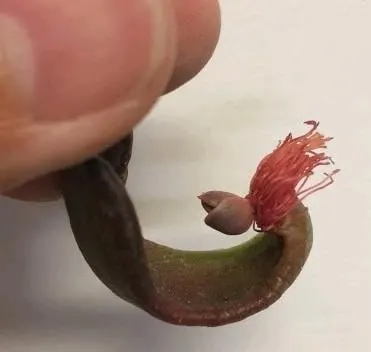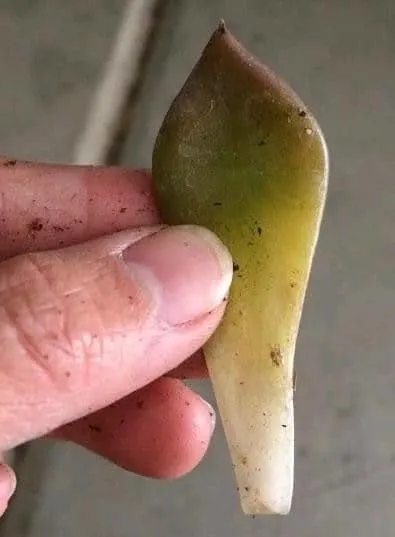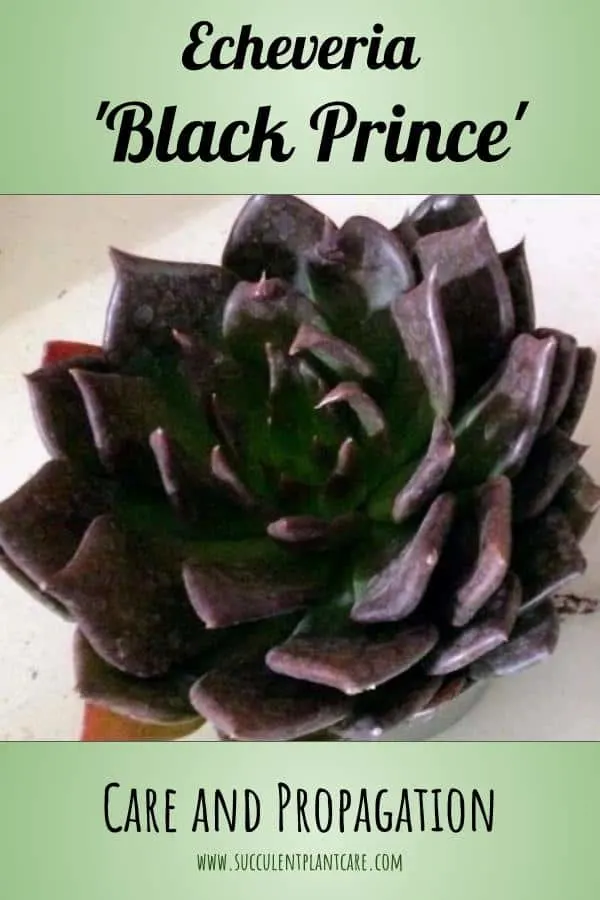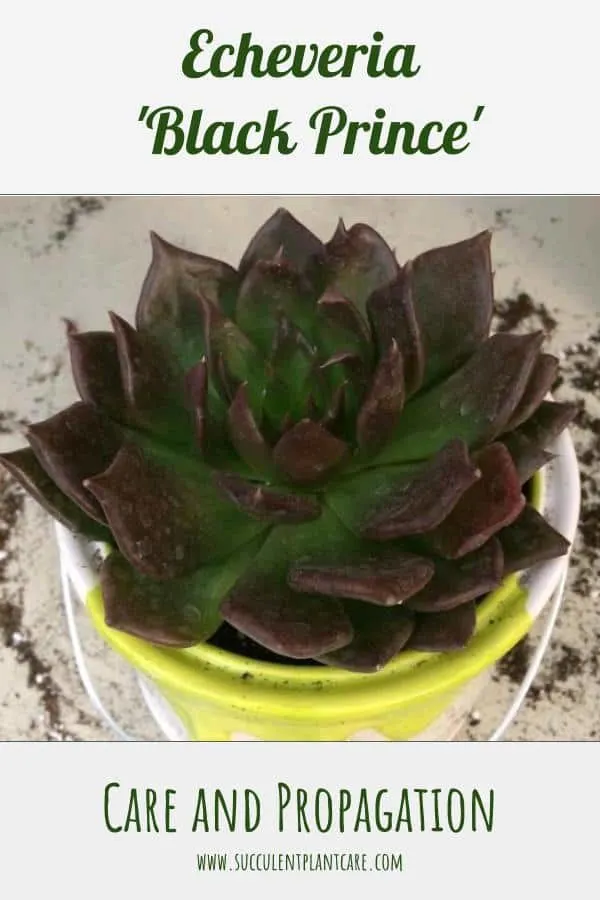Without knowing anything about this plant, the name ‘Black Prince’ alone is enough to conjure drama and anticipation. This beautiful echeveria has gorgeous dark green, purplish and almost black leaves. Upon closer inspection, you will catch a tinge of yellowish green in the center of the rosette which spreads outward to the tips of the leaves.
The dark color intensifies and darkens with more sun exposure. The plant can turn more green when kept in the shade. The leaves are thick, succulent and wide with pointy tips.
It produces dark red flowers which provide a striking contrast to its dark foliage. Echeveria ‘Black Prince’ is a hybrid of two plants: Echeveria shaviana and Echeveria affinis.

Types of Echeveria ‘Black Prince’
Echeveria ‘Black Prince’ Variegated, also known as Echeveria ‘Bess Bates’ is a variegated cultivar of Echeveria ‘Black Prince’. The leaves are variegated with varying shades of yellow, light green, purple and black. The amount of variegation varies from plant to plant, with some having more shades of yellow than others, and some having all the different colors evenly distributed throughout the plant.
These variegated types are more rare and are not as easy to find as the Echeveria ‘Black Prince.’
Echeveria ‘Black Prince’ Care
Are They Indoor or Outdoor Plants?
Echeveria ‘Black Prince’ can be grown both indoors and outdoors. Whether indoors or outdoors, providing the right potting mix (a well draining one) along with proper lighting will give them the best chance at survival. Always adjust watering needs by the amount of light the plant receives.
The more sunlight it receives, the more water it needs and vice versa.
Echeveria ‘Black Prince’ is hardiest in USDA hardiness zones 9-11.
Indoor Lighting Requirements
It is best to provide as much light as possible if kept indoors. Typically speaking, they need approximately 5-6 hours of light per day to thrive. Choose an east facing window.
A south or west facing window will also work. You may need to do a little trial and error before you find the optimal spot for your plant. So be prepared to move it around a few times until you find a spot where it will be happiest.
Echeveria ‘Black Prince’ will not do well in dim areas for too long. Keep in mind that if the plant is not getting enough light indoors, you do not have to water the plant as much. Adjust watering by the amount of light it receives.
If your area does not receive adequate lighting no matter where you move the plant, consider using a grow light. Grow lights are a good investment to have especially if you have long, dark winters. Here are some of my grow light recommendations.
To read more about indoor lighting for succulents, check out my post on “Proper Lighting for Succulents Indoors” to get more helpful tips.
Outdoor Sunlight Requirements
Echeveria ‘Black Prince’ do best in areas that receive plenty of bright, filtered sunlight. Place in a bright sunny location outdoors. They can tolerate partial sun to full sun, but need to be acclimated to full sun to prevent sun damage.
The plant achieves its gorgeous dark purple, almost black hue from increased sun exposure. The more intense the sun exposure, the deeper its color gets. Expect it to turn more greenish when kept in the shade.
Before moving the plant outdoors or increasing the amount of sunlight it receives, it is better to acclimate the plant to help prevent sunburn or sun damage. Slowly increase the amount of sunlight it receives until it is fully acclimated to the sun.
Keep in mind that even when the plant is already acclimated to full sun, it can still get sunburned under intense summer heat or during a heatwave. Once acclimated, they can do pretty well under full sun. The more mature the plant is, the better it can tolerate full sun.
Sunshades are a real lifesaver for my plants during the intense summer heat here in Northern California where the temperatures can rise above 100℉ or 37.8℃. Here are some of my recommendations for sunshades and sun protection.
For further details and information on outdoor sunlight requirements, please visit my post “How Much Sunlight Do Succulents Need Outdoors?” to get some useful tidbits.

Frost Tolerance
Echeveria ‘Black Prince’ may tolerate mild frost and freezing temperatures as long as they are not for prolonged periods of time. If you live in USDA hardiness zones 9-11, you can get away with leaving the plant outdoors all year long. They can even be planted in ground, provided you give them protection from frost or freezing temperatures.
I am lucky to live in sunny California where winters are mild. I keep mines outdoors all year long, and they survive the freezing rain and frost we experience during winter because of all the sun we get during the day. But some nights when the rain seems endless or the temperature drops to freezing, I do need to protect my plants.
If you have extreme winter conditions in your area, the best way to grow these plants are in containers. That way you can bring them indoors during winter or when there is forecast of frost or snow. In case you can’t bring them in, there are ways to protect the plants from frost and freezing temperatures outdoors.
Frost protection such as frost cloths and greenhouses can help them survive the cold winter. Here are some of my recommendations for frost protection.
For further details on this topic, visit my post on “Optimal Temperatures for Succulents to Survive and Thrive.”
Soil Requirements
Just with any other succulent plants, Echeveria ‘Black Prince’ needs a well draining soil. A well draining soil is very important because these plants are susceptible to root rot. I have had great success with using a simple mixture of cactus potting mix combined with perlite for added drainage.
I do not use exact measurements but eyeball it to about 2:1 solution of cactus mix and perlite. Using a sandy soil is also highly recommended. This can be achieved by mixing cactus mix or potting soil with coarse sand (about 2:1 ratio).
I get most of my materials from a local hardware store. You can also purchase them online if needed. Here are my some of my soil recommendations.
To read more about soil for succulents, click on “Best Soil and Fertilizer for Succulents” to get more useful information.
Watering Requirements
Watering largely depends on the climate you live in. Although these plants are highly adapted to dry weather conditions, they do much better when given sufficient amounts of water.
There really isn’t a set schedule or formula on when to water succulents. My watering schedule is dictated by the very dry climate I live in.
In the summer months, I water my Echeveria ‘Black Prince’ as often as every 7-10 days, sometimes more during a heatwave. I cut back on watering to about every 10-14 days when the weather cools down.
During the winter season, I mostly rely on rainwater and hold back on watering altogether because this is when we get a lot of rain in my area. But if we don’t get any rain at all during winter then I water at least once a month or every 2-3 weeks, depending on how dry the soil gets.
In humid climates, you won’t need to water as much. And if you keep your plants indoors, you do not have to water as much especially if they are not receiving a lot of light. Too much water and not enough light is a recipe for disaster for these plants.
One good way to tell whether it’s time to water is to check the moisture of the soil. The top inch of the soil needs to feel dry before you can water again. If you are unsure how much and how often to water in the beginning, it’s always better to underwater and increase watering as needed.
Pay attention to how your plant looks and you can adjust watering accordingly.
For further help with watering techniques, consider using tools like hygrometers or moisture meters to check for moisture in the soil and air. These tools are pretty affordable and can come in handy especially if you are unsure of when to water your plant next. I have narrowed down the choices here on my resource page. Do visit the page if you need help in gauging your watering needs.
Useful Tip: Water the base of the plant instead of from the top. Echeverias have thick leaves and water can collect on the leaves. When they stay wet, rot starts setting in on the leaves.
Interested in finding out more about watering succulents? Visit my post “How And When To Water Succulents” where I go into details about this topic.
Propagating An Echeveria ‘Black Prince’
There are three ways to propagate an Echeveria ‘Black Prince’: through leaf cuttings, from offsets or pups, and by beheadings. The plant may produce pups or offsets that you can remove from the mother plant. If not, you can still propagate by using leaf cuttings. You can also behead the plant especially if it has become leggy or top heavy.


Baby Echeveria ‘Black Prince’ grown from leaf propagation

How to Propagate an Echeveria ‘Black Prince’ Through Leaf Cuttings:
Step 1: Obtain a few leaves preferably starting from the bottom of the plant. That way you don’t end up with a bald looking plant. It is best to use leaves that are plump and not shriveled or dehydrated.
It is also best to use healthy looking leaves and not mushy, translucent ones. Since the stems are thin they shouldn’t take that long to dry. It is also a good idea to obtain cuttings from healthy looking plants, not dehydrated ones.
Start off with a few leaves, not just one because you might lose a leaf or two along the way. Gently twist the leaf off the plant. Make sure to get the whole entire leaf, including the base or the leaf will not make it.
Step 2: Let the leaves dry for a couple of days. Keep in a bright, dry area away from direct sunlight.
Step 3: (Optional) Dip the cut end in rooting hormone. I usually skip this step but some people prefer using rooting hormones to speed up the process and also guarantee success.
Step 4: Once the cut has healed and dried, stick the leaf cuttings in a well draining potting mix or lay the leaf cuttings flat.
Step 5: Keep away from direct sunlight. Water or mist the soil every few days or when the soil feels dry.
Step 6: After about two weeks or so, you will notice new roots growing.
Step 7: After about four to six weeks, you will soon notice new growth developing from the leaves. Keep misting every few days or whenever the soil feels dry.
Step 8: Soon you will notice a baby plant emerge from the leaf. Some leaves will produce one plant, while other leaves will produce more than one. They’re all different. Keep in a bright location but away from direct sunlight.
Step 9: Leaf cuttings take a little longer but soon you will have yourself a big enough plant that you can transplant in its own pot to encourage it to keep growing into a mature plant.
Step 10: Once mature, you can increase the amount of sunlight it receives. Stop misting the plant as it gets bigger and can store more water. Water as you normally would once every 1-2 weeks depending on the humidity in your area.
How to Propagate an Echeveria ‘Black Prince’ from Pups or Offsets:
Step 1: Wait until the pups appear large enough to be removed. The pups are usually hiding under the plant or growing on the underside of the plant. Try to get some roots when removing the pup to give it the best chance at survival.
Likewise, bigger pups are stronger than smaller ones and will have a better chance at surviving on their own.
Step 2: Remove the plant from the pot. It is better to remove the entire plant from the pot before separating the pup so you can see the entire plant including the roots. You may need to use a knife to remove the pup.
Use a clean or sanitized knife and carefully separate the baby plant from its mother plant by inserting the knife blade between the mother plant and the offshoot. Slowly pull apart the pup from the mother plant and sever the connecting root.
Step 3: If removing the pup while still planted in the soil, insert the knife blade into the soil between the mother plant and the offshoot. Slide the blade down the soil to sever the connecting roots. Carve out a 2-inch radius in the soil around the base of the offshoot then dig a few inches down the radial parameter using the sharp end of a small spade.
Insert the spade at an angle underneath the offshoot and carefully pry it loose from the soil to remove.
Step 4: Let the pup dry for about a day or more to make sure any cut or open areas are dry and sealed or calloused. Keep in a dry location away from direct sunlight.
Step 5: (Optional): Dip the pup in rooting hormone before planting. Rooting hormones can help speed this process up especially for pups without roots.
Step 6: Plant the pup. Once the pup is dry it can be planted on its own. Prepare a suitable well draining potting mix and plant the pup into the soil. Pack the soil lightly around the plant until secure.
Step :7 Water occasionally. Pups need a little more moisture than mature plants. Lightly mist the soil with a spray bottle every few days or when the soil feels dry.
Once the plant is more established and rooted, stop misting and water more deeply. You can decrease watering to about once a week or less.
Step 8: Protect from direct sunlight. Protect new plants from direct sunlight when initially planted on its own pot to prevent sun damage. Gradually increase sunlight and sun exposure according to the plant’s needs as the plant matures.
How to Behead an Echeveria ‘Black Prince’
Step 1: If the plant has become leggy or stretched out, you can behead the plant by cutting the top rosette off. Use a clean, sharp knife.
Step 2: Cut off the rosette. Try to leave about an inch of stem on the bottom of the rosette. That way it is easier to stick it in soil later to replant. You also want to have room for new roots to grow.
Step 3: Let the cuttings, both the stump and the top rosette dry for a few days until they have healed and calloused.
Step 4: Once dry, you can stick the rosette in the soil. (Optional: dip in rooting hormone before planting to stimulate faster root growth. I tend to skip this part so your plant will be fine if you skip this too). Use a well draining cactus mix.
Replant the stump in a well draining cactus mix. You can actually replant the stump right away without waiting for it to dry as long as you do not introduce anything wet to the stump or it may rot.
Step 5: In a few weeks, you will notice new roots developing from the bottom of the rosette. After about 3-4 weeks, you will notice new baby plants growing on the sides of the stump.
Step 6: Keep away from direct sunlight and water or mist every few days or whenever the soil feels dry. Decrease watering and increase sunlight as the plants mature.
Common Problems with Growing Echeveria ‘Black Prince’
Yellow Leaves
The most common reason for yellow leaves on an Echeveria ‘Black Prince’ is cultivation issues. And usually this is due to the soil staying wet for too long. If this is the case with your plant, switch out your soil and repot the plant in a more suitable, well draining potting mix (see above for soil suggestions).
Brown Leaves
The most common cause of brown leaves on an Echeveria ‘Black Prince’ is sunburn. Although this plant can take full sun, any extreme weather conditions or extreme changes in weather such as a heatwave can cause sunburn or sun damage. This does not really internally hurt the plant as long as the problem is temporary. If you notice the plant constantly getting sunburned, move the plant to a shadier location or provide shade under taller plants, furniture, or sun shades.
Shriveled Leaves
The most common reason for shriveled leaves on an Echeveria ‘Black Prince’ is underwatering. The leaves will look thin, wrinkly and dried up. When touched, the leaves will feel flat and thin. When this happens, it is a sign that the plant is running low on its water storage and it is time to water. Just give the plant a good drink of water and it should perk up immediately, usually within a day or so. When watering, it is better to water the plant thoroughly as opposed to little mistings here and there. Then leave it alone until it dries out before watering again.
Mushy Translucent Leaves
The most common reason for mushy translucent leaves on an Echeveria ‘Black Prince’ is overwatering. The plant starts looking sick and the leaves will appear lighter or translucent. The leaves will also feel mushy. These are telltale signs that you are overwatering your plant. Simply cut back on watering and allow the plant to dry out and recover from too much water. Do not water until the plant has had a chance to dry out completely. If the soil is not drying out fast enough, consider switching to a fast draining one. These plants are susceptible to root rot when left in wet soil for too long.

Once you notice the plant turning brown or black, it usually means the plant is starting to rot. You can still save the plant by cutting off the rotten dead parts of the plant. Save any leaf and stem that look green and viable to propagate and repot.
Remember, it is easier to ‘fix’ an underwatered plant than an overwatered one so when in doubt, err on the side of caution when watering especially if you are not familiar with the plant.
How to Get an Echeveria ‘Black Prince’ to Bloom
Echeveria ‘Black Prince’ produces bright red, bell-shaped flowers with small, yellow, star-shaped flowers inside. These flowers are really pretty and contrast very nicely with the plant’s dark foliage. Keep in mind that not all plants are ready to flower, and some may not bloom at all.
A lot of it depends on environmental factors beyond our control. To encourage blooms, make sure they are receiving adequate lighting. Along with proper lighting, make sure the plant is kept happy and receiving the proper care as mentioned above.
While fertilizing is not necessary, giving your plants the nutrients they need will help ensure proper growth and encourage blooms. It takes a lot of energy for plants to produce flowers, and feeding them extra nutrients will help supplement their needs during flowering season. The best time to fertilize is during the active growing season, or during spring and summer months.
A balanced blend of fertilizer for houseplants or a fertilizer specially formulated for cacti and succulents are suitable. Fertilizers are better applied at a quarter or half strength, about every two weeks. Here are some fertilizers I recommend.
Along with the right environmental conditions, they also need to go through a wintering period to encourage blooms. This can be achieved by keeping them cool and dry in the winter months, with temperatures just above freezing between 35-44⁰F (1.5-7⁰C).
If you are looking to add drama and flair to your garden, you will not go wrong with an Echeveria ‘Black Prince’. They look great in anything because as we all know, black goes with everything and these ‘Black Prince’ will surely not disappoint.
Where can you find Echeveria ‘Black Prince’ online? Check out my resource page for recommendations on where to purchase these and other succulents online.
Pin this to save for later or share with others!


